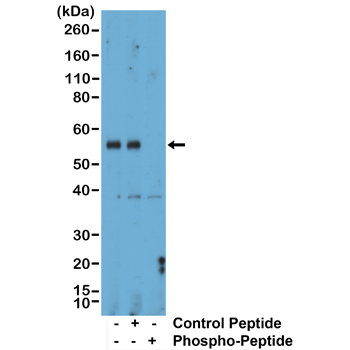anti-Phospho-Smad1 (Ser463/465) / Smad5 (Ser463/465) / Smad9 (Ser465/467) Rabbit Monoclonal (RM487)
| Code | Size | Price |
|---|
| REV-31-1379-00-R100 | 100 ul | £455.00 |
Quantity:
Prices exclude any Taxes / VAT
Overview
Host Type: Rabbit
Antibody Isotype: Rabbit IgG
Antibody Clonality: Recombinant Antibody
Antibody Clone: RM487
Regulatory Status: RUO
Target Species:
- Human
- Mouse
- Rat
Application: Western Blot (WB)
Shipping:
BLUE ICE
Storage:
-20°C
Images
Documents
Further Information
Alternate Names/Synonyms:
SMAD Family Member; Mothers Against DPP Homolog; Mothers Against Decapentaplegic Homolog
Concentration:
N/A
EClass:
32160000
Form (Short):
liquid
Formulation:
Liquid. 50% Glycerol/PBS with 1% BSA and 0.09% sodium azide.
Handling Advice:
Avoid freeze/thaw cycles.
Immunogen:
A phospho-peptide corresponding to human Phospho-Smad1 (Ser463/465)/Smad5 (Ser463/465)/Smad9 (Ser465/467).
Long Description:
Recombinant Antibody. This antibody reacts to Smad1 and Smad5 when phosphorylated at Ser463/465 and Smad9 (Smad8) when phosphorylated at Ser465/467. There is no cross-reactivity to Smad1, Smad5, or Smad9 that are not phosphorylated. This antibody reacts to human, mouse or rat Phospho-Smad1 (Ser463/465)/Smad5 (Ser463/465)/Smad9 (Ser465/467). Source: Rabbit. Isotype: Rabbit IgG. Immunogen: A phospho-peptide corresponding to human Phospho-Smad1 (Ser463/465)/Smad5 (Ser463/465)/Smad9 (Ser465/467). Applications: WB. Members of the Smad family of signal transduction molecules are components of a critical intracellular pathway that transmits TGF-beta signals from the cell surface into the nucleus. Three distinct classes of Smads have been defined: the receptor-regulated Smads (R-Smads), which include Smad1, 2, 3, 5, 8, 9; the common-mediator Smad (co-Smad), Smad4; and the antagonistic or inhibitory Smads (I-Smads), Smad6 and 7. Binding of the TGF-beta superfamily of ligands that includes Transforming Growth Factor-beta (TGF-beta) and bone morphogenetic protein (BMP) to its cognate receptor allows phosphorylation of Smad 1, 2, 3, 5, 8, 9 (R-Smad, Receptor Smad). This signals for heterotrimerization with Smad4 (co-Smad, co-mediator Smad) and translocation of the complex to the nucleus. Inhibitory or antagonistic Smad (I-Smad) that includes Smad 6 and 7, interact with activated R-Smads and attenuate the signaling pathway. Smad4 acts as a tumor suppressor protein by transcriptionally regulating its target genes such as Cyclin D1 (downregulation) and collagen (upregulation) that inhibit cell proliferation. Dephosphorylation regulates nuclear export and nucleocytoplasmic dynamics of Smads.
NCBI, Uniprot Number:
Q15797|Q99717|O15198
Package Type:
Vial
Product Description:
Members of the Smad family of signal transduction molecules are components of a critical intracellular pathway that transmits TGF-beta signals from the cell surface into the nucleus. Three distinct classes of Smads have been defined: the receptor-regulated Smads (R-Smads), which include Smad1, 2, 3, 5, 8, 9; the common-mediator Smad (co-Smad), Smad4; and the antagonistic or inhibitory Smads (I-Smads), Smad6 and 7. Binding of the TGF-beta superfamily of ligands that includes Transforming Growth Factor-beta (TGF-beta) and bone morphogenetic protein (BMP) to its cognate receptor allows phosphorylation of Smad 1, 2, 3, 5, 8, 9 (R-Smad, Receptor Smad). This signals for heterotrimerization with Smad4 (co-Smad, co-mediator Smad) and translocation of the complex to the nucleus. Inhibitory or antagonistic Smad (I-Smad) that includes Smad 6 and 7, interact with activated R-Smads and attenuate the signaling pathway. Smad4 acts as a tumor suppressor protein by transcriptionally regulating its target genes such as Cyclin D1 (downregulation) and collagen (upregulation) that inhibit cell proliferation. Dephosphorylation regulates nuclear export and nucleocytoplasmic dynamics of Smads.
Purity:
Protein A purified.
Source / Host:
Rabbit
Specificity:
This antibody reacts to Smad1 and Smad5 when phosphorylated at Ser463/465 and Smad9 (Smad8) when phosphorylated at Ser465/467. There is no cross-reactivity to Smad1, Smad5, or Smad9 that are not phosphorylated. This antibody reacts to human, mouse or rat Phospho-Smad1 (Ser463/465)/Smad5 (Ser463/465)/Smad9 (Ser465/467).
Transportation:
Non-hazardous
UNSPSC Category:
Primary Antibodies
UNSPSC Number:
12352203
Use & Stability:
Stable for at least 1 year after receipt when stored at -20°C.



